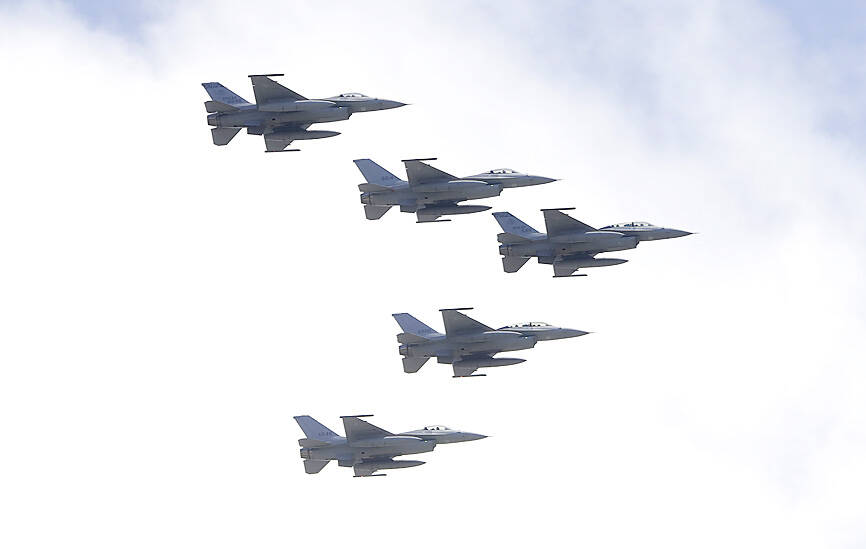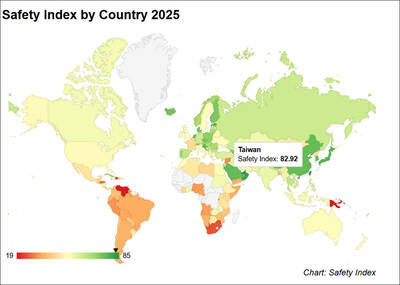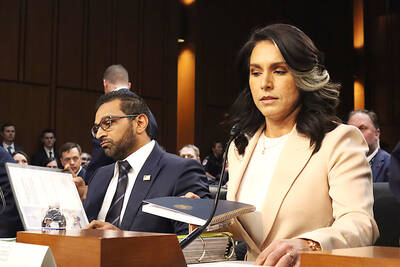Washington informed Taiwan that it has approved a package of up to US$619 million for equipment and munitions related to F-16 jets, the Ministry of Foreign Affairs (MOFA) said yesterday.
The US Department of State notified the US Congress that it has approved the sale, which is likely to pass a vote in Congress within in a month, the Ministry of National Defense said in a statement.
The defense ministry expressed its “sincere gratitude” to the US for approving the sale.

Photo: AP
The package would provide 100 AGM-88B high-speed anti-radiation missiles (HARM), 23 HARM training missiles, 200 AIM-120C-8 advanced medium-range air-to-air missiles (AMRAAM), four AIM-120C-8 AMRAAM guidance systems and 26 LAU-129 multi-purpose launchers, the US Defense Security Cooperation Agency said.
Other munitions and equipment in the package include LAU-118A missile launchers with an aircraft launcher interface computer, HARM missile containers, AIM-120 control sections and containers, AIM-120C captive air training missiles, dummy air training missiles, integration and test support and equipment, and other related elements of logistical and program support, it added.
The main contractors of the missiles would be Raytheon Technologies Corp and Lockheed Martin Corp.
The defense ministry said that the air force has completed combat capability assessments with the AGM-88B and AIM-120C-8 missiles, which are able to further strengthen the defense capabilities protecting Taiwan’s airspace.
The sale also demonstrates Taiwan’s ability to predict the nation’s combat needs and strengthen its armed forces accordingly, it added.
Taiwan is “preparing for war, but not asking for war,” and is determined to boost its self-defense capabilities, the defense ministry said.
The sale is highly welcome, MOFA spokesman Jeff Liu (劉永健) told a news conference yesterday.
The foreign ministry thanked the US for fulfilling its promise in the Taiwan Relations Act and the “six assurances,” he said.
This is the first military sale announced this year by US President Joe Biden’s administration and the eighth in his term, Liu said.
The US continues to normalize arms sales to Taiwan, helping the nation to obtain defense equipment in a timely manner and enhance combat capabilities, he said.
In the face of China’s military expansion, Taiwan would continue to improve its self-defense capabilities and deepen its security relationship with the US, he said.
The sale comes as the defense ministry yesterday reported a second day of large-scale Chinese air force incursions into the nation’s air defense identification zone, with 21 aircraft spotted over 24 hours ending yesterday morning.
The aircraft, 17 J-10 fighters and four J-16 fighters, flew into the southwestern corner of the zone, a defense ministry graphic showed.
The J-10s, an older model that entered service two decades ago, flew closer to the Chinese coast than Taiwan’s, while the J-16s, a much newer and more advanced fighter, flew northeast of the Pratas Islands (Dongsha Islands, 東沙群島), the graphic showed.
Taiwanese air force jets were sent to monitor the Chinese aircraft, the ministry said.
The ministry on Wednesday reported 19 Chinese aircraft flying in the zone.
None of the aircraft crossed the median line of the Taiwan Strait, although 10 Chinese aircraft crossed the line on Friday last week.
Additional reporting by Reuters

AIR SUPPORT: The Ministry of National Defense thanked the US for the delivery, adding that it was an indicator of the White House’s commitment to the Taiwan Relations Act Deputy Minister of National Defense Po Horng-huei (柏鴻輝) and Representative to the US Alexander Yui on Friday attended a delivery ceremony for the first of Taiwan’s long-awaited 66 F-16C/D Block 70 jets at a Lockheed Martin Corp factory in Greenville, South Carolina. “We are so proud to be the global home of the F-16 and to support Taiwan’s air defense capabilities,” US Representative William Timmons wrote on X, alongside a photograph of Taiwanese and US officials at the event. The F-16C/D Block 70 jets Taiwan ordered have the same capabilities as aircraft that had been upgraded to F-16Vs. The batch of Lockheed Martin

GRIDLOCK: The National Fire Agency’s Special Search and Rescue team is on standby to travel to the countries to help out with the rescue effort A powerful earthquake rocked Myanmar and neighboring Thailand yesterday, killing at least three people in Bangkok and burying dozens when a high-rise building under construction collapsed. Footage shared on social media from Myanmar’s second-largest city showed widespread destruction, raising fears that many were trapped under the rubble or killed. The magnitude 7.7 earthquake, with an epicenter near Mandalay in Myanmar, struck at midday and was followed by a strong magnitude 6.4 aftershock. The extent of death, injury and destruction — especially in Myanmar, which is embroiled in a civil war and where information is tightly controlled at the best of times —

Taiwan was ranked the fourth-safest country in the world with a score of 82.9, trailing only Andorra, the United Arab Emirates and Qatar in Numbeo’s Safety Index by Country report. Taiwan’s score improved by 0.1 points compared with last year’s mid-year report, which had Taiwan fourth with a score of 82.8. However, both scores were lower than in last year’s first review, when Taiwan scored 83.3, and are a long way from when Taiwan was named the second-safest country in the world in 2021, scoring 84.8. Taiwan ranked higher than Singapore in ninth with a score of 77.4 and Japan in 10th with

SECURITY RISK: If there is a conflict between China and Taiwan, ‘there would likely be significant consequences to global economic and security interests,’ it said China remains the top military and cyber threat to the US and continues to make progress on capabilities to seize Taiwan, a report by US intelligence agencies said on Tuesday. The report provides an overview of the “collective insights” of top US intelligence agencies about the security threats to the US posed by foreign nations and criminal organizations. In its Annual Threat Assessment, the agencies divided threats facing the US into two broad categories, “nonstate transnational criminals and terrorists” and “major state actors,” with China, Russia, Iran and North Korea named. Of those countries, “China presents the most comprehensive and robust military threat